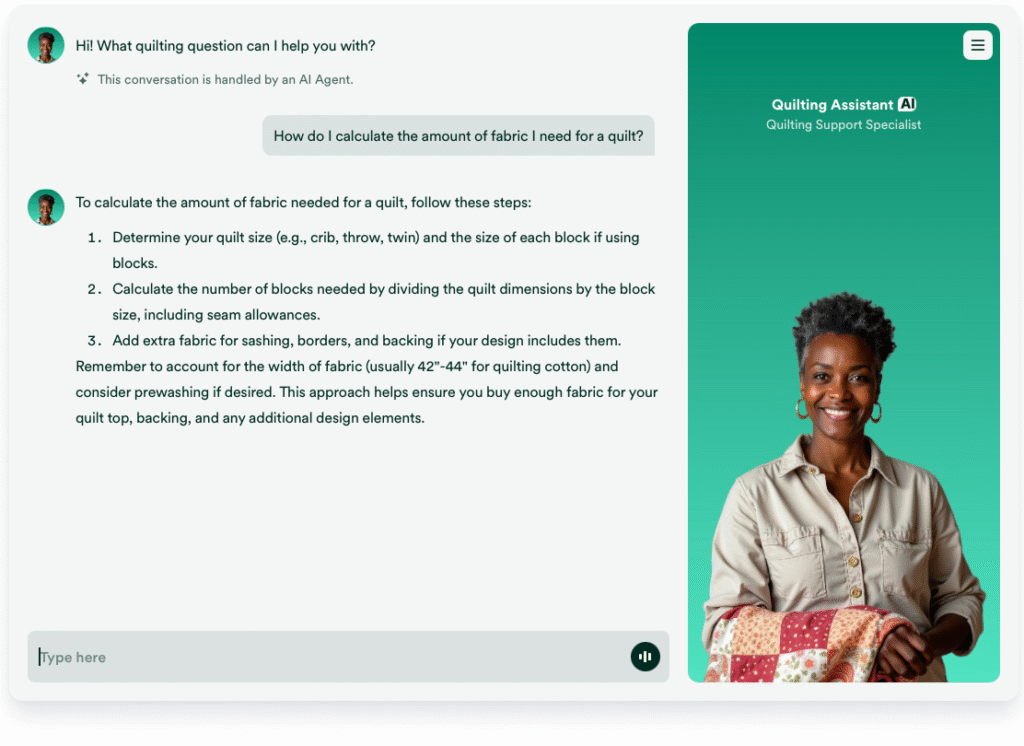Your 24/7 Quilting Expert
The Quilting Assistant is your go-to guide for everything quilting! Whether you’re brand new to quilting or have years of experience, this assistant is here to help you choose fabrics, understand techniques, troubleshoot problems, and get inspired with new ideas.
Quilting can feel overwhelming with so many options for blocks, batting, threads, and finishing techniques. The Quilting Assistant breaks it all down in plain language so you can enjoy the creative process without getting stuck on the details.

Montly Subscription
Pay Month-to-Month-
Quilting Assistant
-
Serger Assistant
Yearly Subscription
Pay for a Year Upfront-
Quilting Assistant
-
Serger Assistant
👉 Subscribe today for as low as $9.99/month and start stitching with confidence!
What the Quilting Assistant Does for You
Fabric selection and preparation (cotton, flannel, specialty fabrics, pre-cuts, etc.)
Cutting, piecing, and block construction techniques
Batting types and uses for different projects
Quilting methods (hand quilting, machine quilting, free-motion, longarm)
Binding, borders, and finishing touches
Tips, tricks, and troubleshooting common issues
- Quilting terminology explained in simple terms
Think of it like a quilting friend who’s always available—ready to answer questions, explain “why,” and offer suggestions you may not have considered.
Ask Away for Expert Advice

What’s the best batting for a lightweight summer quilt?
How do I keep my quilt blocks from stretching when sewing?
What thread weight should I use for machine quilting?
Can you explain the difference between piecing and appliqué?
How do I square up a quilt before adding binding?
What’s the easiest way to join quilt binding ends?
My quilt puckers when I machine quilt—what can I do?
How do I calculate the fabric I’ll need for sashing and borders?
What are some tips for quilting with pre-cut fabric bundles?
Q: What is “scrim” in quilt batting?
A: In quilt batting, “scrim” is a thin stabilizer layer sometimes added onto the batting to anchor the fibers. Its purpose is to keep the batting fibers from separating or stretching, helping maintain the batting’s structure and durability during quilting.
Q: How do I calculate the amount of fabric I need for a quilt?
A: To calculate the amount of fabric needed for a quilt, you first determine the size of the finished quilt and the size of the blocks or pieces you plan to use. Then, calculate the fabric required for the quilt top, including any sashing, borders, and backing fabric, considering the width of the fabric (usually 42″-44″ for quilting cotton). It’s helpful to use a quilt calculator or follow the pattern’s fabric requirements, and always add extra fabric for cutting errors and seam allowances.
Q: Which batting is best to use when making a baby quilt?
A: For a baby quilt, the best batting is typically cotton or a cotton/poly blend because these options are soft, breathable, and gentle on a baby’s skin. Cotton batting has low loft and is breathable, making it comfortable and natural, while cotton/poly blends offer durability and easier care. Avoid high-loft or synthetic-only battings that may be too warm or less breathable for babies.
✨ The Quilting Assistant is designed to save you time, reduce frustration, and keep quilting fun. Whether you’re finishing your first quilt or planning your next masterpiece, this assistant is here to guide you every step of the way.
Montly Subscription
Pay Month-to-Month-
Quilting Assistant
-
Serger Assistant
Yearly Subscription
Pay for a Year Upfront-
Quilting Assistant
-
Serger Assistant